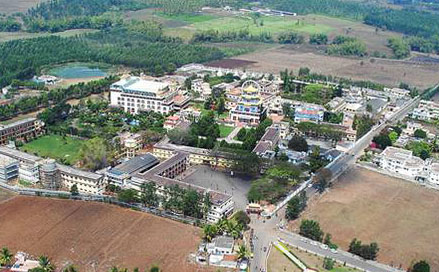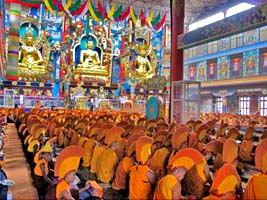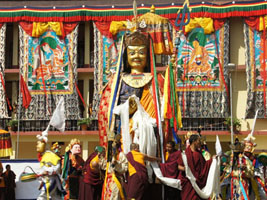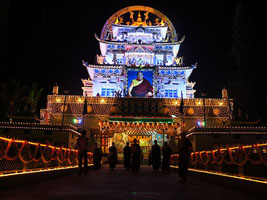
His Holiness Penor Rinpoche, the spiritual leader of the Nyingmapa Palyul Lineage, began building Namdroling Monastery with his own hands in 1963. At this moment, the Monastery has about 5,000 monks and nuns. Let us pray for the blessings from the Buddhist doctrine, May they bring real peace and comfort to the world.
Original
At the age of five he was brought to Palyul Monastery and at twelve formally appointed as the eleventh throneholder of Palyul Monastery in the presence of Chogtrul Rinpoche Thupten Choekyi Dawa and Karma Kuchen. His Holiness Penor Rinpoche received the empowerments, oral transmissions and pith instructions of Kama and Terma teachings from them and also studied sutra and tantra under various erudite scholars. After completing and excelling in his education, he assumed the responsibility of benefiting the dharma and sentient being through his manifold enlightened activities. In the year 1959, His Holiness Penor Rinpoche fled to India following the Chinese invasion of Tibet. He gradually reached South India, Mysore, Bylakuppee Tibetan Settlement in 1961. In order to preserve the Lord Buddha's teachings for the sake of sentient beings he established Namdroling Monastery, the second seat of Palyul Monastery on the tenth of the sixth Tibetan month, 1963. His Holiness Penor Rinpoche also gathered the Sangha community and gave monastic vows that are the basic foundation to higher Buddhist learning and practices. Realizing that the only means to uphold the doctrine is through expounding and practice, he invited Khen Rinpoche Thubten Tsondru Phuntsok, the then renowned Nyingma scholar to assist him in setting up a centre for learning higher Buddhist education. Later on 17th February 1978, on the 10th day of the First Tibetan month, His Holiness Penor Rinpoche established Ngagyur Nyingma Institute for Higher Tibetan Studies and Research Centre. With accordance to the distinct philosophical views and concepts of great Nyingma scholars and masters such as Longchenpa, Rongzompa, and Mipham, religious studies were carried out in the Institute guided by Khenpo Pema Sherab as well as many other scholars. Presently more than eight hundred monks stay in the Institute for nine years during which the vast and profound sutra and tantra teachings as well as common sciences including Tibetan Grammar, Poetry, Religious History etc, are thoroughly studied, debated and researched.
Process
His Holiness Penor Rinpoche personally gave instructions on Thregchoe (Cutting through Practice), and Thodgal (Crossing Over Practice) Dzogchen practice based on Namcho Sangye Lakchang (Buddha in the Palm of Hand) to those who stay in the retreat. Every month, on the tenth and twenty-fifth day, the monks of the monastery assemble to say prayers for the well being of the devotees in this and their future lives. Meanwhile they are also taught ritual rites including ritual dance, mandala construction, chanting, as well as using religious musical instruments. The Primary School of Namdroling Monastery gives eight years of basic education to nearly 800 students where they learn how to read and write, Tibetan Grammar, memorizing prayers, general knowledge of Buddhist philosophy, meditation, and conduct. Likewise, a parental home has been set up for aged people where food, shelter, clothing and Dharma teachings are provided. On the 27th November, 1993, Tsogyal Shedrubling Nunnery was established to give basic and higher religious education to nuns coming from Tibet, Bhutan, Nepal and so forth. Like NNI, an institute with a nine years course has also been set up for higher Buddhist studies. Beginners are trained in reading and writing, Tibetan grammar, and memorization of prayers. The nuns have to attend a primary school with an eight years course together with learning religious rites and rituals. The Nunnery has the strength of 800 nuns who study, contemplate and meditate continuously. They also observe the ceremonies of the lunar 10th and 25th Guru Rinpoche and Vajrayogini days, during which they make feast offerings. They also assemble during special occasions to say prayers for the well being of all. Regarding the physical environment, the Monastery has many religious monuments to its credit such as eight stupas of Lord Buddha, Terton Migyur Dorje's reliquary stupa, prayer wheels, temple of NNI, Vajrakilaya temple, Kagyed temple, Tara temple, libraries of NNI and monastery, and the famous newly built Golden Temple. In short, His Holiness Penor Rinpoche provided all the basic amenities to monks and nuns including food, clothing, medicine, accommodation as well as Dharma teaching. Despite his tight schedule in looking after the welfare of the Monastery and its many branches, he compassionately bestowed various rare and precious empowerments, oral transmissions and pith instructions of the Nyingma Teachings. he gave the Rinchen Terzoed empowerments to monks, nuns and lay persons. These were some of his manifold enlightened activities for the benefit of the teachings as well as sentient beings.
Lineage At Namdroling Monastery, the students spend eight years in primary school. Afterwards they stay in the Dratsang (literally monks quarters) for three years to learn ceremonial rituals in accordance with what has been taught by the realized masters of the past. The next year they must complete the 500,000 accumulations of the preliminary practices which include taking refuge, generating bodhicitta, offering mandala, recitation of Vajrasattva and Guru Yoga. Thereafter, if the student shows a satisfactory academic record, who can enroll in the Institute for Higher Buddhist Studies and Research. There the student attends a nine-year course of study during which he becomes learned in the sutras and tantras, as well as in other fields of study; afterwards the student will not need to rely on external sources of scriptural knowledge. After leaving the Institute, the student is required to accept teaching responsibilities for at least three years. If he successfully completes his service to the Monastery and possesses excellent outer and inner qualities, he will be conferred the title "khenpo", which means great learned teacher. Both Khenpos and Lopons (teachers) are solely working for the benefit of all beings by teaching in Namdroling and other monasteries and schools in and outside India. In the Samten Oseling retreat centre, more than fifty monks recite the root mantras of Nyingthig (Heart Essence), Ratling (the treasure discovered by the treasure revealer Ratna Lingpa) and Namchoe ("Space Teaching", taught by Avalokiteshvara to the treasure revealer Mingyur Dorje). They also meditate diligently on the generation and completion stages. In total, Namdroling is the home of more than five thousand monks. The Tsogyal Shedrubling Nunnery provides the same learning opportunities as the Monastery, including primary school and the nine-year course of higher studies. After the completion of their studies, they continue to serve the Nunnery as per its rules and regulations. More than eight hundred nuns are enrolled at this time. There is a total of 24 years of combined studies for each monk or nun. His Holiness had given over a thousand monk-hood vows. Besides giving teachings and empowerments, he also helped solve various problems of the lay people. Everyday, from morning till night, His Holiness selflessly benefitted all the living, the dying and the sentient beings beyond. During his four trips to Tibet, His Holiness rebuilt the main Palyul Monastery and many branch monasteries. At other times, he visited the centers in Hong Kong, Taiwan, Singapore, Malaysia, Philippines, US, UK, France and other countries, where various teachings and empowerments were provided to countless disciples. At the Nyingma Monlam Chenmo Prayer in Bodh Gaya, India, His Holiness Penor Rinpoche was unanimously appointed the Supreme Head of all the Nyingma in 1993 after His Holiness Dudjom Rinpoche and Dilgo Khyentse Rinpoche. Jigme Phuntsok Rinpoche often praised His Holiness Penor Rinpoche as being a true Buddha in the flesh. His Holiness the Dalai Lama has also praised His Holiness Penor Rinpoche for his contribution and efforts to disseminate the Nyingma teachings in public many times.
|



]
¢xGyang Khang Rinpoche ¢xTeachings ¢xActivities ¢xPublications ¢xBuddhist Activities ¢xMedia Zone¢x ¤¤¤å ¢x |



